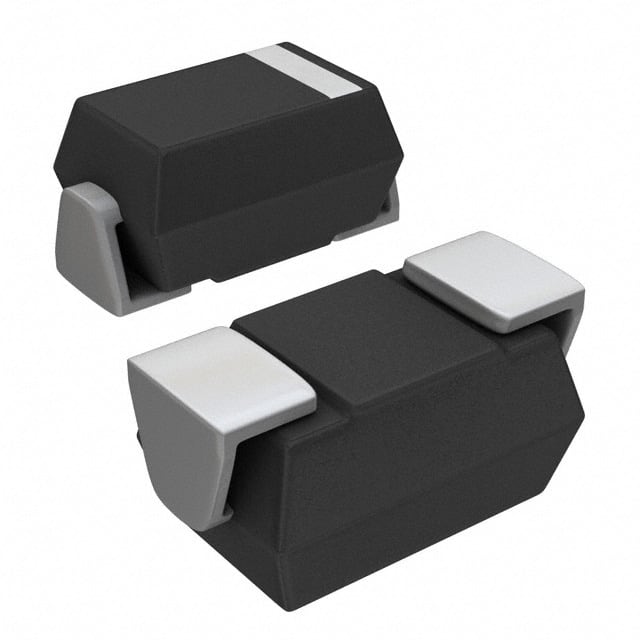SS12E-TP Product Overview
Introduction
SS12E-TP is a versatile electronic component that belongs to the category of Schottky diodes. This entry provides an in-depth overview of SS12E-TP, including its basic information, specifications, detailed pin configuration, functional features, advantages and disadvantages, working principles, application field plans, and alternative models.
Basic Information Overview
- Category: Schottky Diode
- Use: Rectification, voltage clamping, and reverse current protection in various electronic circuits.
- Characteristics: Low forward voltage drop, fast switching speed, and low leakage current.
- Package: SOD-123FL
- Essence: Semiconductor material with a metal-semiconductor junction.
- Packaging/Quantity: Available in tape and reel packaging with varying quantities.
Specifications
- Forward Voltage Drop (VF): 0.3V maximum
- Reverse Voltage (VR): 20V
- Average Rectified Current (IO): 1A
- Operating Temperature Range: -65°C to +125°C
- Storage Temperature Range: -65°C to +150°C
Detailed Pin Configuration
SS12E-TP follows the standard SOD-123FL package configuration with two pins for connection.
Functional Features
- Fast Switching Speed: Enables rapid response in electronic circuits.
- Low Forward Voltage Drop: Minimizes power dissipation and heat generation.
- Low Leakage Current: Ensures minimal current flow in the reverse direction.
Advantages and Disadvantages
Advantages
- Efficient rectification and voltage clamping.
- Compact package size for space-constrained applications.
- Suitable for high-frequency applications.
Disadvantages
- Limited reverse voltage capability compared to other diode types.
- Susceptible to thermal runaway at high currents.
Working Principles
SS12E-TP operates based on the Schottky barrier principle, where the metal-semiconductor junction allows for faster switching and lower forward voltage drop compared to conventional PN-junction diodes.
Detailed Application Field Plans
SS12E-TP finds extensive use in various electronic circuits, including: - Power supplies - Voltage clamping circuits - Signal demodulation circuits - Switching power converters - Reverse polarity protection circuits
Detailed and Complete Alternative Models
Several alternative models to SS12E-TP include: - SS14E-TP: Higher reverse voltage (40V) variant - SS16E-TP: Higher reverse voltage (60V) variant - SS24E-TP: Higher reverse voltage (40V) and higher average rectified current (2A) variant
In conclusion, SS12E-TP serves as a crucial component in electronic circuits requiring efficient rectification, voltage clamping, and reverse current protection. Its unique characteristics and compact package make it suitable for a wide range of applications, while alternative models provide flexibility to accommodate specific design requirements.
Word Count: 366
قم بإدراج 10 أسئلة وإجابات شائعة تتعلق بتطبيق SS12E-TP في الحلول التقنية
What is SS12E-TP?
- SS12E-TP is a type of solid-state relay (SSR) that provides reliable switching for various technical solutions.
What are the key features of SS12E-TP?
- The key features of SS12E-TP include high reliability, fast switching speed, low power consumption, and compatibility with a wide range of control signals.
How can SS12E-TP be used in industrial automation?
- SS12E-TP can be used in industrial automation for controlling motors, heaters, and other electrical loads with its fast and reliable switching capabilities.
Is SS12E-TP suitable for use in HVAC systems?
- Yes, SS12E-TP is suitable for use in HVAC systems to control fans, pumps, and other components due to its high reliability and low power consumption.
Can SS12E-TP be used in lighting control applications?
- Absolutely, SS12E-TP is commonly used in lighting control applications to switch and dim LED lights, fluorescent lamps, and other lighting fixtures.
What is the maximum load capacity of SS12E-TP?
- The maximum load capacity of SS12E-TP varies depending on the specific model, but it typically ranges from 10A to 40A.
Does SS12E-TP support DC and AC loads?
- Yes, SS12E-TP is designed to support both DC and AC loads, making it versatile for a wide range of technical solutions.
Are there any special considerations for integrating SS12E-TP into a control system?
- When integrating SS12E-TP into a control system, it's important to ensure proper heat dissipation and consider the input voltage and current requirements.
Can SS12E-TP be used in harsh environments?
- Yes, SS12E-TP is often used in harsh environments due to its solid-state design, which provides resistance to shock, vibration, and extreme temperatures.
What are the typical applications where SS12E-TP excels?
- SS12E-TP excels in applications such as industrial machinery, process control, robotics, and energy management systems due to its reliability and fast switching capabilities.


